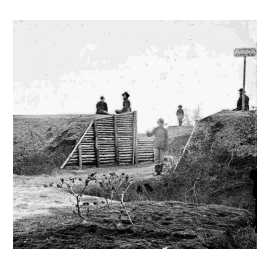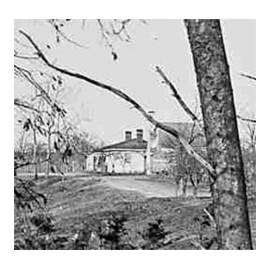Dodd Park at Point of Rocks
Bermuda Hundred Campaign in Chesterfield County, VA
Dodd Park at Point of Rocks
Prior to Union occupation of the Point of Rocks area, a Confederate signal station was located there. On June 28, 1862, Federal gunboats approached Point of Rocks during McClellan's Peninsula Campaign. The foray was turned back by the Surry Light Artillery who had their guns placed on top of the large rock outcropping just downriver form the current park. A lucky shot by one of the Surry Artillery's antiquated guns disabled a Federal gunboat. The boat was set on fire and abandoned in the Appomattox River.
The memoirs of Private B.W. Jones recount this episode where a small band of Confederates at Point of Rocks repulsed the Union Army three years before the siege of Petersburg. The elevated location of Point of Rocks provided a logical point for a signal station or observation tower. The clearest accounts of this action were printed under the "Stars and Bars: A history of The Surry Light Artillery, Reflections of a Private Solider in the War Between the States". The Everett Waddy Company privately printed this account in Richmond in 1902. Private Jones' account; recorded June 28, 1862, recounts that on June 26" as a roll call was being taken: a boom of a cannon was heard downriver, and a shell flew through the camp signaling the approach of the Union Army gunboats on Point of Rocks. There were other rounds of fire that apparently tried to uncover where Confederate troops might be located.
There were about 60 Confederate troops at Point of Rocks, concealed by the large boulders on the bluff. The leading The leading Union gunboat was some 50 yards from the Confederate position when they were halted by Confederate fire. The fall of darkness and the elevated position of the Confederate troops aided their defense. Confederate reinforcements under the command of J.T. West took up a position behind the large boulders on this bluff. They fired into the gunboat's portholes when they opened. The infantry remained sheltered by the "masses of rock that lie around on either side of the Point." The battle lasted for over two hours. The Confederates placed a shell though the hull one of the boats "that obliged them to run the craft aground," to keep it from sinking in deep water. The Union troops took off their valuables and then burned and abandoned the boat. The natural bluffs at Point of Rocks therefore checked this Union advance and probably prolonged the life of the Confederacy and the war. (Pictured left is Dodd Park in 1865)
Dod Park at Point of Rocks Continued
Point of Rocks Union Hospital
The Union Hospital at Point of Rocks 1864-65
The hospital originally consisted of tents set up in the orchard around the Strachan House. The tents were 50 feet long and contained enough cots and bunks to accommodate 40 or more patients. As the Bermuda Hundred Campaign gave way to the Siege of Petersburg the hospital developed into a large complex of wood buildings. The hospital was organized into divisions to distribute patients according to disease. Dr. Moses Greeley Parker, a surgeon at Point of Rocks, described one division as consisting of 17 wards, each 80 feet long, 20 feet wide and 8 feet high, built of logs and grouped like a horseshoe on the bluff. Other divisions contained 8 wards that were each 250 feet long, 30 feet wide and 15 feet high. These large wards could accommodate 180 patients each. It is estimated that over 3,000 patients would have been at Point of Rocks at any given time. (See the photograph above far right)





